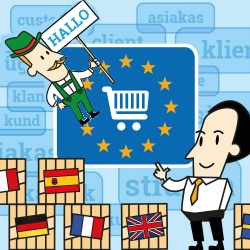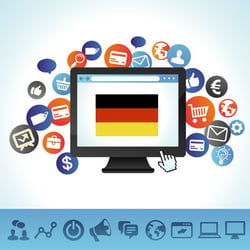In 2014, Germany boasted over 51 million online consumers, only superseded by China, Japan and the USA. In terms of e-commerce, Germany comes 2nd in Europe after the UK, with over €41 Bn annual online sales, as reported by the German E-Commerce and Distance Selling Trade Association.
 E-commerce sector represented 9% of Germany’s total retail industry in 2014. The German E-Commerce and Distance Selling Trade Association forecasted a 12% growth in 2015, reaching a revenue of nearly €47 Bn. Other sources predict even higher growth rates, between 20-30%. According to the Association of the German Internet Industry, more than half (53%) of German GDP generated in 2017 will be e-commerce related (compared to 37% in 2012).
E-commerce sector represented 9% of Germany’s total retail industry in 2014. The German E-Commerce and Distance Selling Trade Association forecasted a 12% growth in 2015, reaching a revenue of nearly €47 Bn. Other sources predict even higher growth rates, between 20-30%. According to the Association of the German Internet Industry, more than half (53%) of German GDP generated in 2017 will be e-commerce related (compared to 37% in 2012).
Information sources vary in the estimated total of e-commerce sales and their predictions of European e-commerce growth figures because of different definitions of online e-commerce; some focusing on B2C only, others including the important B2B sector. Despite these differences, they all agree that Germany is and will be enjoying one of the highest growth rates. The market is not as mature as the UK one, but is certainly huge and booming. This blog will introduce some of the typical features and trends of the German e-commerce market.
If you want to tackle the German market, but are not ready to sell online, there is no need to give up just yet, because we have some good news for you. Germans are fans of researching online and purchasing offline, which provides a great opportunity for smaller companies and international exporters. In order to ensure that you will be included in your potential buyer’s shortlist, you need to have a local online presence - website in German language, localized for the German audience and optimized for German search engines (google.de is a leader with 93% share of all online searches in Germany). Search engine optimization combined with another online marketing channel, such as social media, will help you increase your online visibility in Germany. If you’d like to know more about creating a website for a German market, read our ebook.
I want to sell online! How?
The German online retail space is led by Amazon (both no. of e-shoppers and turnover), followed by other general or sector specific retailers, such as Otto, Tchibo, Conrad Electronics, Zalando, Cyberport, H&M, and Notebooksbilliger.de. These online retail channels will help you take a chunk of the huge German e-commerce spend, but will not help you build your brand, increase your visibility, build your customer loyalty, build your credibility and enhance your reputation. Owning your own online presence is especially important for companies that provide solutions or unique products rather than commodities. In that case you will need your own e-commerce website. Understanding expectations of German e-shoppers will help you become successful in that regard.
What are the expectations of German e-shoppers?
Payment methods
Restrictive or inappropriate payment methods discourage many customers from buying online. A study conducted by the E-Commerce-Center reported that over 80% of e-shoppers consider the availability of their preferred payment method to be very or absolutely important. According to BITCOM, only 10% of German e-shoppers purchase using a credit card! The most popular online payment method are online payment services. An internationally known example of this payment method is PayPal. However, many e-shoppers prefer local providers, such as sofortueberweisung.de, SOFORT or giropay. Many Germans don’t even own a VISA, MasterCard or AmEx, because the majority of traditional stores only accept typically German EC-cards (which are, however, not accepted online!).
 Fast delivery
Fast delivery
According to the German Trade and Industry, option of a same-day delivery to your online customers offers a significant competitive advantage. This can be fairly easily fulfilled given that Germany, home of DHL, has a highly developed logistics infrastructure with many other logistics suppliers that compete to fulfil online orders. A number of recent studies concluded that online sales would increase if a same-day delivery option was offered. “Click and Collect” is another popular way how to provide superior delivery service, but is dependent on a fairly dense network of retail stores or partners across Germany.
Returns
Germany has an average return rate of 13%. If you’re a US company, you need to be aware that Returns are not a question of company policy. All EU online stores have to comply with the EU-wide purchase withdrawal rights. All consumers have a 14 days “cooling off” period after the goods are received. The seller must refund the full product cost + shipping costs to the customer if the goods are returned for any reason. The return rates vary by sector and are especially high in the fashion, textiles, and shoes sectors (26%). Accurate product descriptions and visual representations will help you lower the return rate.
Mobility
Mobile e-commerce (m-commerce) is experiencing rapid growth in Germany, but mobile devices have even greater importance in the preliminary research stages before an order is placed. Having a website with responsive design or a mobile app will improve customer’s experience, which often contributes towards his/her final decision. The German Trade and Industry reports that 25% of German smartphone users state that they manage the entire purchasing process via smartphones – making the mobile channel a serious income stream.
Personalization
Providing a unique, customized, interactive shopping experience is a clear global online trend and German e-shoppers are certainly not lagging behind in their expectations either. This for example includes personalized product offer based on browsing history or provided personal data. Before you start planning and creating personalized processes, we recommend that you test that your website is user-friendly. It is important to ensure that the website is intuitive, easy to navigate around helps prevent errors.
Terms & Policies
German e-shoppers expect you to adhere to all required legislation and reflect that in your Terms & Conditions (AGB - Allgemeine Geschäftsbedingungen), they expect you to provide information on website’s owner on a separate and easily found page called Impressum and to comply with the EU directive on data privacy (including cookies). We recommend that US companies consider becoming part of the Safe-Harbor program.
Find more information on these and other e-commerce issues, as well as links to other websites with more details on e-commerce policies in our ebook
Main information and statistics source: Germany Trade and Invest - Gesellschaft für Außenwirtschaft und Standortmarketing mbH http://www.gtai.de/GTAI/Navigation/EN/Invest/Industries/Digital-economy/e-commerce.html


